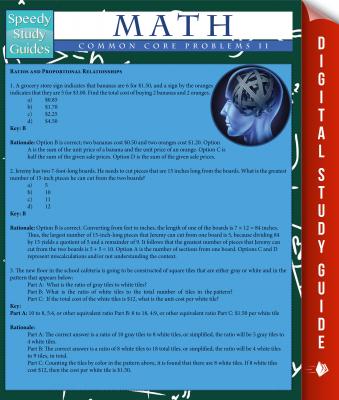ТОП просматриваемых книг сайта:
Math Common Core Problems Il (Speedy Study Guides). Speedy Publishing
Читать онлайн.Название Math Common Core Problems Il (Speedy Study Guides)
Год выпуска 0
isbn 9781633839410
Автор произведения Speedy Publishing
Жанр Математика
Издательство Ingram
RATIOS AND PROPORTIONAL RELATIONSHIPS
1. A grocery store sign indicates that bananas are 6 for $1.50, and a sign by the oranges indicates that they are 5 for $3.00. Find the total cost of buying 2 bananas and 2 oranges.
a)$0.85
b)$1.70
c)$2.25
d)$4.50
Key: B
Rationale: Option B is correct; two bananas cost $0.50 and two oranges cost $1.20. Option
A is the sum of the unit price of a banana and the unit price of an orange. Option C is half the sum of the given sale prices. Option D is the sum of the given sale prices.
2. Jeremy has two 7-foot-long boards. He needs to cut pieces that are 15 inches long from the boards. What is the greatest number of 15-inch pieces he can cut from the two boards?
a) 5
b)10
c)11
d)12
Key: B
Rationale: Option B is correct. Converting from feet to inches, the length of one of the boards is 7 × 12 = 84 inches.
Thus, the largest number of 15-inch-long pieces that Jeremy can cut from one board is 5, because dividing 84 by 15 yields a quotient of 5 and a remainder of 9. It follows that the greatest number of pieces that Jeremy can cut from the two boards is 5 + 5 = 10. Option A is the number of sections from one board. Options C and D represent miscalculations and/or not understanding the context.
3. The new floor in the school cafeteria is going to be constructed of square tiles that are either gray or white and in the pattern that appears below:
Part A: What is the ratio of gray tiles to white tiles?
Part B: What is the ratio of white tiles to the total number of tiles in the pattern?
Part C: If the total cost of the white tiles is $12, what is the unit cost per white tile?
Key:
Part A: 10 to 8, 5:4, or other equivalent ratio Part B: 8 to 18, 4:9, or other equivalent ratio Part C: $1.50 per white tile
Rationale:
Part A: The correct answer is a ratio of 10 gray tiles to 8 white tiles, or simplified, the ratio will be 5 gray tiles to 4 white tiles.
Part B: The correct answer is a ratio of 8 white tiles to 18 total tiles, or simplified, the ratio will be 4 white tiles to 9 tiles, in total.
Part C: Counting the tiles by color in the pattern above, it is found that there are 8 white tiles. If 8 white tiles cost $12, then the cost per white tile is $1.50.
4. A clothing store offers a 30% discount on all items in the store.
Конец ознакомительного фрагмента.
Текст предоставлен ООО «ЛитРес».
Прочитайте эту книгу целиком, купив полную легальную версию на ЛитРес.
Безопасно оплатить книгу можно банковской картой Visa, MasterCard, Maestro, со счета мобильного телефона, с платежного терминала, в салоне МТС или Связной, через PayPal, WebMoney, Яндекс.Деньги, QIWI Кошелек, бонусными картами или другим удобным Вам способом.

